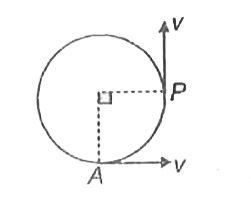A particle is moving on a circular path with constant speed v. The magnitude of the change in its velocity after it has described an angle of 90∘ is :
v
√2v
0
√3 v
The correct Answer is:b
To solve the problem of finding the magnitude of the change in velocity of a particle moving in a circular path after it has described an angle of 90 degrees, we can follow these steps:
1. Understanding Initial and Final Velocity:
- The particle is moving with a constant speed v in a circular path.
- At the initial position, let's assume the particle is at point A, moving along the positive x-axis. Thus, the initial velocity vector →Vi can be represented as:
→Vi=v^i
- After moving through an angle of 90 degrees, the particle will be at point B, moving along the positive y-axis. Therefore, the final velocity vector →Vf can be represented as:
→Vf=v^j
2. Calculating Change in Velocity:
- The change in velocity Δ→V is given by:
Δ→V=→Vf−→Vi
- Substituting the values of →Vf and →Vi:
Δ→V=v^j−v^i
- This can be rewritten as:
Δ→V=−v^i+v^j
3. Finding the Magnitude of Change in Velocity:
- The magnitude of the change in velocity |Δ→V| can be calculated using the Pythagorean theorem:
|Δ→V|=√(−v)2+(v)2
- Simplifying this:
|Δ→V|=√v2+v2=√2v2=v√2
4. Conclusion:
- Therefore, the magnitude of the change in velocity after the particle has described an angle of 90 degrees is:
|Δ→V|=√2v
Final Answer:
The magnitude of the change in velocity is √2v.
---
- The particle is moving with a constant speed v in a circular path.
- At the initial position, let's assume the particle is at point A, moving along the positive x-axis. Thus, the initial velocity vector →Vi can be represented as:
→Vi=v^i
- After moving through an angle of 90 degrees, the particle will be at point B, moving along the positive y-axis. Therefore, the final velocity vector →Vf can be represented as:
→Vf=v^j
- The change in velocity Δ→V is given by:
Δ→V=→Vf−→Vi
- Substituting the values of →Vf and →Vi:
Δ→V=v^j−v^i
- This can be rewritten as:
Δ→V=−v^i+v^j
- The magnitude of the change in velocity |Δ→V| can be calculated using the Pythagorean theorem:
|Δ→V|=√(−v)2+(v)2
- Simplifying this:
|Δ→V|=√v2+v2=√2v2=v√2
- Therefore, the magnitude of the change in velocity after the particle has described an angle of 90 degrees is:
|Δ→V|=√2v
The magnitude of the change in velocity is √2v.
Topper's Solved these Questions
- INTRODUCTION TO VECTORS & FORCES Book:VMC MODULES ENGLISHChapter:INTRODUCTION TO VECTORS & FORCES Exercise:level 2
Explore 64 Videos
- INTRODUCTION TO VECTORS & FORCES Book:VMC MODULES ENGLISHChapter:INTRODUCTION TO VECTORS & FORCES Exercise:JEE Main ( ARCHIVE ) ( LEVEL-1)
Explore 12 Videos
- INTRODUCTION TO VECTORS & FORCES Book:VMC MODULES ENGLISHChapter:INTRODUCTION TO VECTORS & FORCES Exercise:JEE Advanced ( ARCHIVE LEVEL-2)
Explore 12 Videos
- GRAVITATIONBook:VMC MODULES ENGLISHChapter:GRAVITATIONExercise:JEE Advance (Archive) TRUE/FALSE
Explore 1 Video
- JEE MAIN - 5Book:VMC MODULES ENGLISHChapter:JEE MAIN - 5Exercise:PART I : PHYSICS (SECTION - 2)
Explore 5 Videos
Similar Questions
Knowledge Check
A particle is moving on a circular path with a constant speed v. Its change of velocity as it moves from A to B is:
 A2vsin(2θ)BzeroC2vsin(θ2)D2vcos(θ2)
A2vsin(2θ)BzeroC2vsin(θ2)D2vcos(θ2)A particle is moving on a circular path of radius r with uniform speed v. What is the displacement of the particle after it has described an angle of 60∘?
Ar√2Br√3CrD2r
A body is moving in a circular path with a constant speed. It has .
View SolutionA particle is moving along a circular path with a constant speed 10ms−1.What is the magnitude of the change in velocity of the particle ,when it moves through an angle of 60∘ around the center of the circle ?
View SolutionA particle is moving on a circular path with constant speed, then its acceleration will be constant in
View SolutionAn object moving in a circular path at constant speed has constant
View SolutionA car is moving in a circular path with a uniform speed v. Find the magnitude of change in its velocity when the car rotates through an angle θ.
View SolutionA particle of mass 2 kg is moving in circular path with constant speed 20 m/s. The magnitude of change in velocity when particle travels from A to P will be

View Solution
